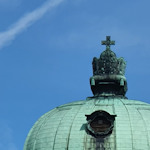
What was once a giant abbey complex in the country now sits at the very edge of Vienna. Stift Klosterneuburg contains numerous treasures within its historical walls.
- Dates back to 1114
- Romanesque, Gothic, Baroque & all things in between (and after)
- Basic ticket includes the remarkable treasury
- Consider upgrading to a tour there
- …includes the imperial rooms, Verdun altar, and more
- Book a classical concert* in a church or palais
- See also:
900+ years of history

(The abbey from a distance; © Stift Klosterneuburg / Michael Zechany)
Klosterneuburg abbey is one of those places where history is measured out in stone, marble and gold. Where a few hundred years and a couple of architectural eras can slide by within the space of a few metres.
Technically in the province of Lower Austria, the surrounding town exudes a certain upmarket charm. It also borders Vienna; the abbey windows even give views down to the capital’s high-rise buildings.
In the beginning…
The Babenberg Margrave Leopold III and his wife, Agnes, founded Stift Klosterneuburg in 1114 and lived next door. Just under 20 years later, the Order of the Augustinian Canons moved in.
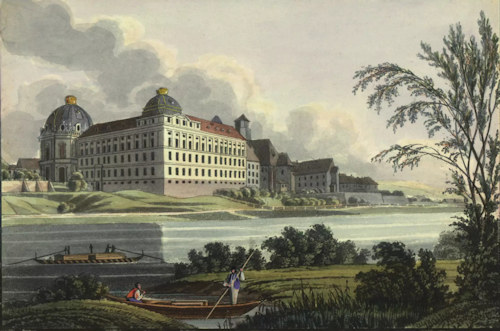
(A view of the Danube area around Klosterneuburg by the artists Joseph Ignaz Gurk and Eduard Gurk, published around 1825 by Tranquillo Maria Laurentio Mollo; the Danube has since moved, as rivers did back in the day; Wien Museum Inv.-Nr. 106509/26; excerpt reproduced with permission under the terms of the CC0 licence)
Apart from a brief interlude during WWII, the community of priests has never left and currently numbers around 37.
Today’s abbey continues its pastoral role with responsibility for some 28 parishes. It also manages a lot of land that includes significant wine-growing properties (with implications for the abbey shop!)
Most importantly for us, Stift Klosterneuburg is a prime visitor attraction thanks to its history, the size and architecture of the complex, the cultural treasures within, and the nearness to Vienna.
Leopold, incidentally, remains an important figure in Austrian history. Canonised in 1485, he is the country’s patron saint (and Vienna’s). His son, the admirably-named Henry II Jasomirgott became the first Duke of Austria and moved his residence to Vienna. And so began the rise and rise of the city.

(The abbey also enjoys fame for its wines, press photo © Stift Klosterneuburg/Michael Zechany)
What can you see there?
The complex essentially consists of three parts (though historians will no doubt scoff at the simplicity of my description):
- The former Babenberg residential area
- The church and ecclesiastical areas
- The Imperial residential wing
That highly-decorative Baroque Imperial wing came about in the early 1700s, when Emperor Charles VI decided to add the local equivalent of the Spanish royal residence of El Escorial to one end of the abbey.
In a cunning move, Charles worked out that the cheapest way to pay for the monumental construction with four courtyards and nine domes was, well…not to. He obliged the abbey to cover the costs.
To the likely relief of the abbey’s accountants, Charles died in 1740 well before completion. His successors showed no interest in continuing the project, so the priests quietly shelved the blueprints.
What you see today represents “only” about a fourth of the emperor’s original plans.
Still, that incomplete project has gifted us a lovely Baroque façade and various Imperial rooms that bear comparison to the likes of Vienna’s Schönbrunn and Belvedere palaces.
Casual visitors can stroll around the abbey exterior, enjoy the small landscaped gardens, and walk through the former Babenberg courtyard. You can also go into the church for a view down the nave (but you can’t go inside more than a couple of metres).
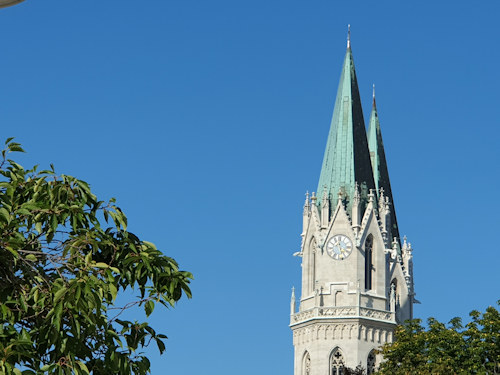
(Towers of the Klosterneuburg abbey church)
The visitor centre itself makes for an interesting visit, being within the huge Sala Terrena entrance hall to the planned Baroque residence. Except it’s less Baroque and more unfinished extension, despite the mammoth wall statues and similar. Everything is more or less as it was when work ended there in 1740.
The rest of the abbey’s treasures (and I mean that both literally and figuratively) require an entrance and optional tour ticket.
Tickets & visitor tips
I would recommend at least getting the basic entrance ticket, since this allows you to see the (summer) exhibition, the abbey museum (restricted opening times) and, critically, the Schatzkammer treasury.
The three-room treasury feels like a mini amalgam of Vienna’s own Schatzkammer, Dom Museum, and Kunstkammer chamber of wonders.
Quite a few items require a double take; an innocent detailed ivory relief, for example, turns out to be over 1000 years old.
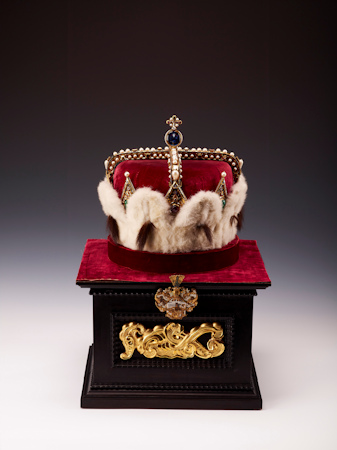
(The Austrian archducal coronet; © Stift Klosterneuburg / Janos Stekovics)
The accumulated ecclesiastical and historical treasures certainly do justice to the name.
View golden jeweled chalices from the 1700s. A 1679 silver filigree model of the original plague column on Vienna’s Graben. Historical liturgical garments. Reliquary skulls from the 1600s and Limoges reliquary boxes from around 1200. Astonishing 3D ivory carvings of judgment day from the early 18th century. A nativity scene of red coral from the 17th century.
And much more.
That “much more” includes, for example, what is almost certainly Agnes’s original bridal veil. And the highlight is surely the Archducal Coronet; its repository shrine has some serious-looking locks.
This insignia of the Archduchy of Austria was made in the early 1600s for Maximilian III and traditionally only leaves Klosterneuburg for the inauguration of a new Archduke (the last such occasion was 1835).
Given the end of the monarchy after WWI, it seems this rather lovely piece of headwear will stay put for the foreseeable future.
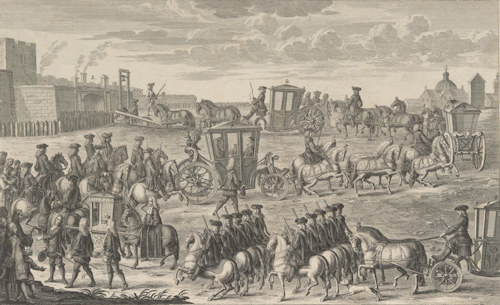
(Retrieval of the archducal coronet from Klosterneuburg on September 22nd, 1705, on occasion of the hereditary homage paid to Joseph I by the lower Austrians. Drawn by Johann Cyriak Hackhofer and engraved by Christian Engelbrecht and Johann Andreas d. Ä. Pfeffel, 1705; Wien Museum Inv.-Nr. 198956; excerpt reproduced with permission under the terms of the CC0 licence)
The coronet has gold and ermine, diamonds, pearls, rubies, emeralds and a giant sapphire on top. Not something for wearing to breakfast.
Beyond that, the abbey offers various guided tours for a small upgrade fee.
These tours are the only way to access certain locations, including the wonderful Verdun altar, the cloisters, the Imperial rooms built for Charles VI, and inside the church.
We went on the Grand Tour of the Abbey, which took us everywhere but the wine cellars (a separate tour): read about our tour experience.
A few additional tips:
- Ask for an English-language audio guide. The treasury, for example, has exhibit labels that provide titles only
- You also need an audio guide for any of the tours, since these are in German only. On our tour, the guide told audio guide users which numbers to press as we moved through the complex, and this multilingual solution proved fine
- Do check on opening times for the museum. It typically opens for a couple of hours on afternoons at the weekend and public holidays
- The abbey complex and surrounding area have plenty of places to eat, drink and buy a bottle or three of abbey wine; they even have a separate abbey wine store
- You’re also in walking distance of the Albertina Klosterneuburg: a museum featuring works by renowned modern and contemporary artists
How to get to the Abbey
Although technically outside of Vienna, Klosterneuburg is closely integrated within the Viennese transport system.
If you have network tickets for Vienna, you need to purchase an extra (very inexpensive) ticket to reach Klosterneuburg and return. We’ve used two routes to get there and back:
- The S40 city train drops you a short walk from the abbey at the Klosterneuburg-Kierling station. The train leaves every 30 minutes or so at the time of writing. Catch the S40 from, for example, Heiligenstadt station (on the U4 subway) or Spittelau (on the U6 subway) for a journey of around 9-10 minutes
- The 400 bus leaves more regularly than the S40 but takes a little longer. Get off at the Klosterneuburg Stiftsgarten stop, which drops you more or less at the bottom of the abbey gardens. The 400 departs from Heiligenstadt for a journey of some 15-17 minutes.
Address: Stiftsplatz 1, 3400 Klosterneuburg | Website